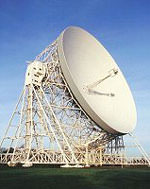
Image credit: ESA
Controllers have made two more attempts to reach the Beagle 2 lander, which was thought to have entered Mars’ atmosphere on December 25: once with both the Jodrell Bank radio telescope and again with Mars Odyssey. Although they’re disappointed, the engineers still have a few tricks up their sleeves. A special team has been put together, and is working around the clock to devise solutions for potential problems with the lander; if there are hardware or software problems, or if it’s ended up at an unusual angle. People will really start to lose hope in early January when Mars Express reaches its final polar orbit – it’s the spacecraft Beagle 2 was designed to communicate with.
Two attempts to communicate with Beagle 2 during the last 24 hours – first with the 76 metre (250 feet) Lovell Telescope at Jodrell Bank Observatory in Cheshire, UK, and then this morning with the Mars Odyssey orbiter – ended without receiving a signal. Despite this outcome, fresh attempts to scan for a signal from Beagle 2 will be made over the coming days.
Meanwhile, scientists and engineers are eagerly awaiting ESA’s Mars Express spacecraft return close enough to Mars to try to establish contact with Beagle 2. This may be possible from 4 January 2004.
Mars Express was always intended to be the prime communication relay for Beagle 2, and the lander team is hopeful that a link can be established at that time if it has not already been achieved with Mars Odyssey.
“We need to get Beagle 2 into a period when it can broadcast for a much longer period,” says Professor Colin Pillinger, Beagle 2 lead scientist. “This will happen around the 4 January after the spacecraft has experienced a sufficient number of communication failures to switch to automatic transmission mode.”
Both Professor Pillinger and Professor David Southwood, ESA Director of Science, agreed that the best chance to establish communication with Beagle 2 would now seem to be through Mars Express.
At present, Mars Express is far from the planet and preparing to fire its engines for a major trajectory change that will move it into a polar orbit around Mars.
“We will have no satisfaction until we have a full mission” said Professor Southwood. “Today I’m certainly frustrated, but I’m still confident: let’s wait now until the mothership will have the possibility to get in contact with her baby. With Mars Express we will be using a system that we have fully tested and understand.”
Original Source: ESA News Release
